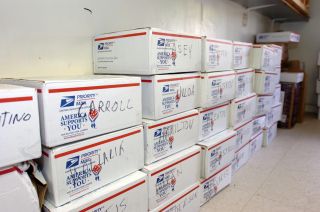Resilience
The Anatomy of the Military Care Package
A good care package can make a servicemember’s day.
Updated December 4, 2023 Reviewed by Michelle Quirk
Key points
- Good packages include specific requests, food, clothes, things to do, hygiene items, and personalized items.
- The number-one clothing item appreciated by deployed service members is a really good pair of socks.
- Personalized items like a photo or letter are typically the most valued items in a care package.
Do you have a loved one who is deployed, and you want to mail them something? Does your organization want to send care packages to troops? Awesome—servicemembers love getting care packages, and they bring immediate psychological health benefits. Care packages brighten their day and make them feel cared for and appreciated. A care package can result in a significant increase in mood and literally turn someone’s day around.

Servicemembers are necessarily a discriminating audience, though, and there is both art and science involved in putting together a package that will bring joy and utility. A thoughtful care package is composed of a number of tried and true categories: specific requests, food, clothes, things to do, hygiene items, and personalized items from home.
Specific Requests
The most important item in a care package headed to someone you know is that thing they truly need and can’t get where they are. Thus, if they ask you for something specific, take the time to find and ship it.
Food
Servicemembers have plenty of food on deployment. It’s not a need for food that makes food in care packages great; it’s surprise, variety, favorites, and flavor. With the idea of mailing food comes challenges though, and liquids, chocolate, perishables, and anything in a glass container can cause problems for the integrity of the entire care package.
Thus, as it relates to food, these are the things to think about when putting together the care package: Where is this care package going? What are the temperatures going to be along the way? How long is it going to take to get there? If the care package is headed overseas to a remote area or to a deployed ship (as examples), this is going to limit what you can include.
Foods that can generally be mailed anywhere are jerky, nuts and sunflower seeds, peanut butter, crackers, tuna packets, energy bars, some kinds of candy, prepackaged cookies and snack cakes, flavored water and instant coffee packets, trail mix, pretzels, seasonings, and individual condiment packets.
Clothing
Depending on where you are sending this package, clothes may or may not be useful. However, generally, the number-one clothing item appreciated by deployed service members is a really good pair of socks. I’m not talking about the bargain three-packs from large chain stores; I’m talking about the quick-dry/moisture-wicking, high-quality socks that are specially made for people who are on their feet all day in boots in extreme temperatures and environments.
Other clothing suggestions are underwear, an extra pair of bootlaces, and/or t-shirts.
Things to Do
Deployments and long stretches away from home are usually punctuated by periods of boredom. Service members are grateful to receive ways to pass the time. Reading materials are always great things to send—books and (current!) magazines can be passed around and benefit everyone. Journals and sketchbooks/pencils are also appreciated.
Baseballs, footballs, and frisbees are excellent ways to enable service members to stay active and social and benefit the group. If you want to take your care package to new heights, include a couple of baseball gloves. Likewise, board games can be enjoyed by everyone.
Video games, movies, podcasts, etc. are a great way to spend downtime on deployment; however, be sure to do your research on what digital infrastructure service members have where you are sending the package. This ensures that they will be able to use what you send.
Personal Hygiene Items
Specific personal hygiene items any individual service member typically uses are probably not going to be what’s available while deployed. Think about sending these on a regular basis. However, because obtaining any hygiene items on deployment can be challenging, you can’t really go wrong with sending the plethora of items. If your service member doesn’t need it, someone will.
Things to send include extra toothbrushes, toothpaste, dental floss, disposable razors, shaving cream, shampoo, conditioner, over-the-counter pain relievers, pain-relief cream, foot powder, lip balm, skincare, and, if applicable, high-quality, feminine hygiene items.
Some things that service members use a lot of, namely hand sanitizer and baby wipes, may already be widely available. Before you fill the care package, find out about this and try not to send things that are amply supplied already.
One great approach to hygiene and self-care items is to accumulate a wide variety of trial/travel-size items. Special treats are high-end hair treatment masques and luxury brand skincare trial samples.
Personalized Items
If you are sending a care package to someone you know, there is nothing like getting an actual, hold-in-your-hands letter with updates from home; a picture drawn by a son, daughter, niece, or nephew; and/or an actual hard copy photo that they can carry with them or tack up on their “wall” next to their cot, rack, bunk, etc. These types of items are typically the most valued and meaningful items in a care package.
Two final thoughts on care packages for the military. Remember that your care package is about to make a journey, consisting of transfers, drives, and flights, at least one of them as cargo on military aircraft, while stacked under a bunch of other packages. Pack it well and put any hygiene items, or food items that could compromise the rest of the package, in a sealed, plastic storage bag.
And, last, remember that not everyone is as fortunate as your care package recipient. Send enough for your service member to share, or even consider sending a second care package for your service member to gift to someone who could use a pick-me-up. Mail continues to be a primary morale booster for our service members who are away from home and is a great way to show support.




